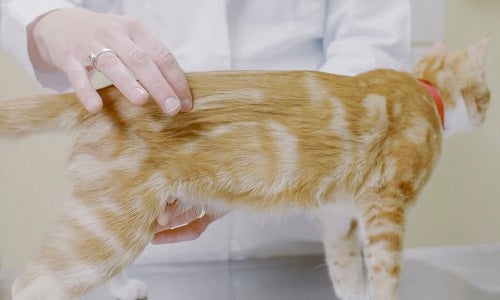Practice Scenario

Meet GENERAL
A 13-year-old, neutered-male, Domestic Shorthair
- General is trim, with a body condition score of 5/9 and normal muscle mass.
- His owner reports that the cat is generally healthy, but may not be as active as he once was. The owner thinks General may be sleeping more.
- An indoor-outdoor cat, General eats mostly dry cat food, with occasional treats of canned food. When outdoors, he may or may not eat whatever prey he catches.
Muscle Condition Assessment
Use Muscle Condition Scoring to Detect Muscle Loss in Patients
The 4-point muscle condition scoring system, available for both cats and dogs, is a practical, hands-on evaluation that can be performed by veterinary health care professionals and pet owners to regularly monitor a pet’s muscle mass. When used in conjunction with body weight and body condition score (BCS), muscle condition score (MCS) can offer a clearer picture of a dog’s or cat’s body composition, muscle-to-fat ratio and nutritional status.

Key Messages
- Maintaining lean body mass (LBM) is important for a pet’s overall health and has been associated with longevity in cats and dogs. LBM comprises skeletal muscles, internal organs, bones, skin — every part of the body except fat.
- Lean body mass serves as an amino acid reservoir from which dogs and cats can build the proteins that are essential components of every cell, including immune cells and red blood cells.
- Lean body mass loss decreases a pet’s strength, depresses immune function, and reduces the ability to heal after illness, injury or surgery.
- Sarcopenia, defined as age-related loss of LBM (particularly muscle) in the absence of disease, is common in older cats and dogs.
- Loss of LBM also occurs during certain chronic diseases (e.g., congestive heart failure and chronic kidney disease), injury or sudden illness, which is known as cachexia.
- Loss of lean body mass in sarcopenia is often accompanied by an increase in body fat, so the pet’s body weight may remain the same and mask the loss of lean tissue.
- Evaluating muscle mass over the spine, shoulder blades, skull and hips using a 4-point MCS system can help identify LBM losses so steps can be taken to intervene when muscle loss is in an early stage.
- Although age-related sarcopenia cannot be prevented, feeding a higher protein diet may help slow down the loss of lean body mass, including muscle.

"You are probably aware that we weigh [pet's name] as part of every physical examination. Body weight gives us only part of the picture about your pet’s body composition and nutritional status. We also evaluate your pet's body condition and muscle condition, recording these in your pet's medical record so we can monitor for changes over time. Loss of muscle and lean body mass can be associated with aging, and although we cannot prevent age-related loss of lean body tissues, we can switch [pet's name] to a higher protein diet to help slow it down."
Additional Resources
Cupp, C. J., Kerr, W. W., Jean-Philippe, C., Patil, A. R., & Perez-Camargo, G. (2008). The role of nutritional interventions in the longevity and maintenance of long-term health in aging cats. International Journal of Applied Research in Veterinary Medicine, 6(2), 69─81.
Freeman, L. M. (2012). Cachexia and sarcopenia: Emerging syndromes of importance in dogs and cats. Journal of Veterinary Internal Medicine, 26(1), 3─17. doi: 10.1111/j.1939-1676.2011.00838.x
Kealy, R. D., Lawler, D. F., Ballam, J. M., Mantz, S. L., Biery, D. N., Greeley, E. H., Lust, G., Segre, M., Smith, G. K., & Stowe, H. D. (2002). Effects of diet restriction on life span and age-related changes in dogs. Journal of the American Veterinary Medical Association, 220(9), 1315─1320. doi: 10.2460/javma.2002.220.1315
Lawler, D. F., Larson, B. T., Ballam, J. M., Smith, G. K., Biery, D. N., Evans, R. H., Greeley, E. H., Segre, M., Stowe, H. D., & Kealy, R. D. (2008). Diet restriction and ageing in the dog: Major observations over two decades. British Journal of Nutrition, 99(4), 793─805. doi: 10.1017/S0007114507871686
Penell, J. C., Morgan, D. M., Watson, P., Carmichael, S., & Adams, V. J. (2019). Body weight at 10 years of age and change in body composition between 8 and 10 years of age were related to survival in a longitudinal study of 39 Labrador retriever dogs. Acta Veterinaria Scandinavica, 61(1), 42. doi: 10.1186/s13028-019-0477-x
